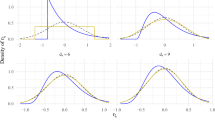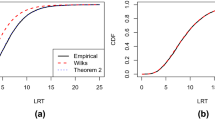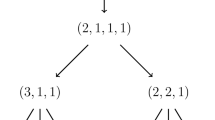Abstract
For multiple populatios, a longtidinal factor analytic model which is entirely exploratory, that is, no explicit identification constraints, is proposed. Factorial collapse and period/practice effects are allowed. An invariant and/or stationary factor pattern is permitted. This model is formulated stochastically. To implement this model a stagewise EM algorithm is developed. Finally a numerical illustration utilizing Nesselroade and Baltes' data is presented.
Similar content being viewed by others
References
Bayley, N. (1955). On the growth of intelligence.American Psychologist, 10, 805–818.
Bellman, R. (1960).Introduction to matrix analysis. New York: McGraw-Hill.
Bentler, P. M. (1973). Assessment of developmental factor change at the individual and group level. In J. R. Nesselroade & P. B. Baltes (Eds.),Life-span developmental psychology (pp. 145–174). New York: Academic Press.
Bieber, S. L., & Meredith, W. (1986). Transformation to achieve a longitudinally statioonary factor pattern matrix.Psychometrika, 51, 535–547.
Browne, M. W. (1984). Asymptotically distribution-free methods for the analysis of covariance structures.British Journal of Mathematical and Statistical psychology, 37, 62–83.
Cattell, R. B. (1963). Theory of fluid and crystallized intelligence: A critical experiment.Journal of Educatioonal Psychology, 54, 1–22.
Clark, M. P. (1944). Changes in primary mental abilities with age.Archives of Psychology, 291, 30.
Cudeck, R., & Browne, M. W. (1983). Cross-validation of covariance structures.Multivariate Behavioral Research, 18, 147–167.
Dempster, A. P., Laird, N. M., & Rubin, D. B. (1977). Maximum likelihood from incomplete data via the EM algorithm.Journal of the Royal Statistical Society, Series B,39, 1–38.
Guttman, L. (1956). “Best possible” systematic estimates of communalities.Psychometrika, 21, 273–285.
Jöreskog, K. G. (1971). Simultaneous factor analysis in several populations.Psychometrika, 36, 409–426.
Jöreskog, K. G. (1979). Statistical estimation of structural models in longitudinal-developmental investigations. In J. R. Nesselroade & P. B. Baltes (Eds.),Longitudinal research in the study of behavior and development (pp. 303–351). New York: Academic Press.
Jöreskog, K. G. & Sörbom, D. (1984).LISREL VI: Analysis of linear structural relationships by the method of maximum likelihood. Chicago: Scientific Software.
Jöreskog, K. G. & Sörbom, D. (1985). Simultaneous analysis of longitudinal data from several cohorts. In W. M. Mason & S. E. Fienberg (Eds.),Cohort analysis in social research (pp. 323–341). New York: Springer-Verlag.
Kroonenberg, P. M., Lammers, C. J., & Stoop, I. (1985). Three-mode principal component analysis of multivariate longitudinal organizational data.Sociological methods & review, 14, 99–136.
Kroonenberg, P. M., & Lewis, C. (1982). Methodological issues in the search for a factor model: Exploration through confirmation.Journal of Educational Statistics, 7, 69–89.
Lohmöller, J. B. (1978).How longitudinal factor stability, continuity, differentiation, and integration are portrayed into the core matrix of three-mode factor analysis. Paper presented at the European Meeting on Psychometrics and Mathematical Psychology, Uppsala, Sweden.
Lord, F. M. (1980).Applications or item response theory to practical testing problems. Hillsdale, NJ: Lawrence Erlbaum.
Lord, F. M., & Novick, M. R. (1968).Statistical theories of mental test scores. Menlo Park, CA: Addison-Wesley.
Mardia, K. V. (1970). Measures of multivariate skewness and kurtosis with applications.Biometrika, 57, 519–530.
McDonald, R. P. (1978). A simple comprehensive model for the analysis of covariance structures.British Journal of Mathematical and Statistical Psychology, 31, 59–72.
Meredith, W. (1964a). Notes on factorial invariance.Psychometrika, 21, 177–186.
Meredith, W. (1964b). Rotation to achieve factorial invariance.Psychometrika, 20, 187–206.
Meredith, W., & Tisak, J. (1982). Canonical analysis of longitudinal and repeated measures data with stationary weights.Psychometrika, 47, 47–67.
Meredith, W., & Tisak, J. (in press). Latent curve analysis.Psychometrika.
Millsap, R. E., & Meredith, W. (1988). Component analysis in cross-sectional and longitudinal data.Psychometrika, 53, 123–134.
Nesselroade, J. R., & Baltes, P. B. (1974). Adolescent personality development and historical change: 1970–1972.Monographs of the Society for Research in Child Development, 39, (1, Serial No. 154).
Olsson, U., & Bergman, L. R. (1977). A longitudinal factor model for studying change in ability structure.Journal of Multivariate Behavioral Research, 12, 221–241.
Rubin, D. B., & Thayer, D. T. (1982). EM algorithms for ML factor analysis.Psychometrika, 47, 69–76.
SAS Institute. (1985).The MATRIX Procedure (Tech. Rep. P-135. Cary, NC: Author.
Schaie, K. W. (1965). A general model for the study of developmental problems.Psychological Bulletin, 64, 92–107.
Schönemann, P. H. (1985). On the formal differentiation of traces and determinants.Multivariate Behavioral Research, 20, 113–139.
Spearman, C. (1904). “General intelligence,” objectively determined and measured.American Journal of Psychology, 15, 201–293.
Swaminathan, H. (1984). Factor analysis of longitudinal data. In H. G. Law, C. W. Snyder, Jr., J. A. Hattie, & R. P. McDonald (Eds.),Research methods for multimode data analysis (pp. 308–332). New York: Prageger.
Thomson, G. H. (1951).The factorial analysis of human ability. Loondon: University of Londoon Press.
Thursstone, L. L., & Thurstone, T. G. (1982).SRA Primary Mental Abilities. Chicago: Science Research Associates.
Tisak, J. (1984).Exploratory Longitudinal factor analysis in multiple populations with application to growth in intelligence. Unpublished doctoral dissertation, University of California, Berkeley.
Tisak, J., & Meredith, W. (1986), June).“Tuckerizing” curves for latent variables. Paper presented at the annual meeting of the Psychometric Society, Toronto, Canada.
Tucker, L. R. (1963). Implications of factor analysis of three-way matrices for measurement of change. In C. W. Harris (Ed.),Problems in measuring change (pp. 122–137). Madison, WI: University of Wisconsin Press.
Verdonik, F., & Sherrod, L. R. (1984).An inventory of longitudinal research on childhood and adolescence. New York: Social Science Research Council.
Vinsonhaler, J. F., & Meredith, W. (1966). A stochastic model for repeated testing.Multivariate Behavioral Research, 1, 461–477.
Author information
Authors and Affiliations
Additional information
The authors wish to thank Barbara Mellers and Henry Kaiser for their helpful comments and John Nesselroade for providing us the data for our illustration. This research wwa supported in part by a grant (No. AG03164) from the National Institute on Aging to William Meredith. Details of the derivations and a copy of the PROC MATRIX program are available upon request from the first author.
Rights and permissions
About this article
Cite this article
Tisak, J., Meredith, W. Exploratory longitudinal factor analysis in multiple populations. Psychometrika 54, 261–281 (1989). https://doi.org/10.1007/BF02294520
Received:
Revised:
Issue Date:
DOI: https://doi.org/10.1007/BF02294520




